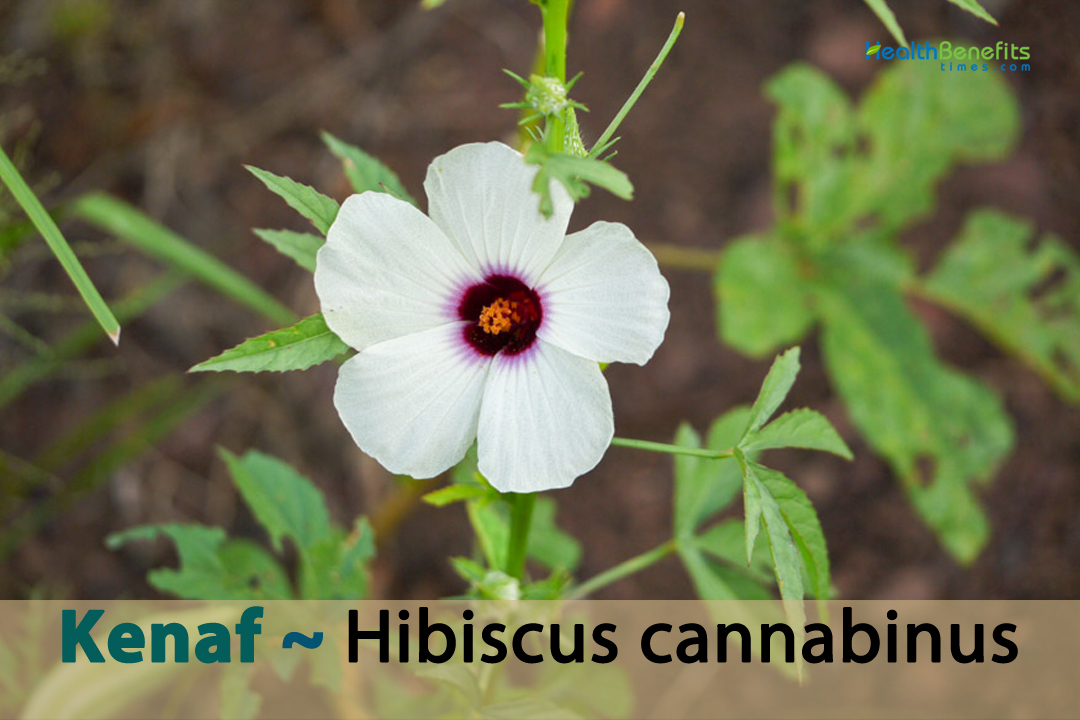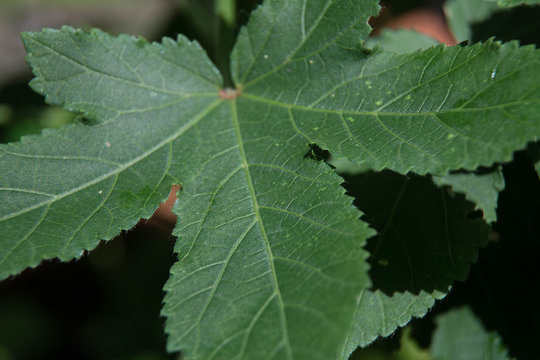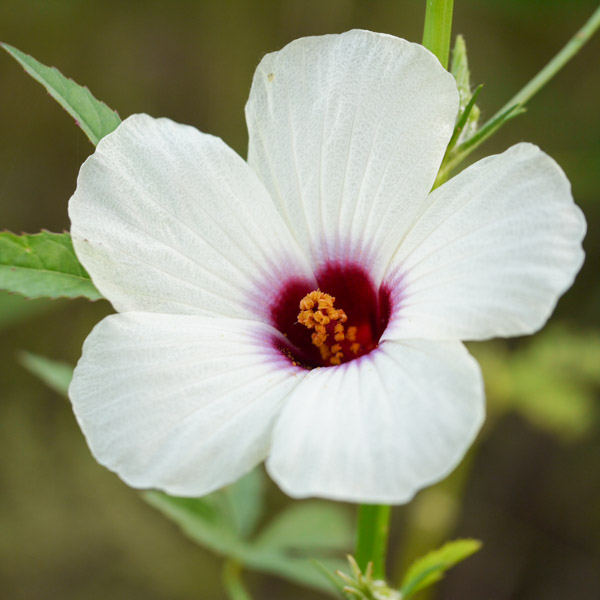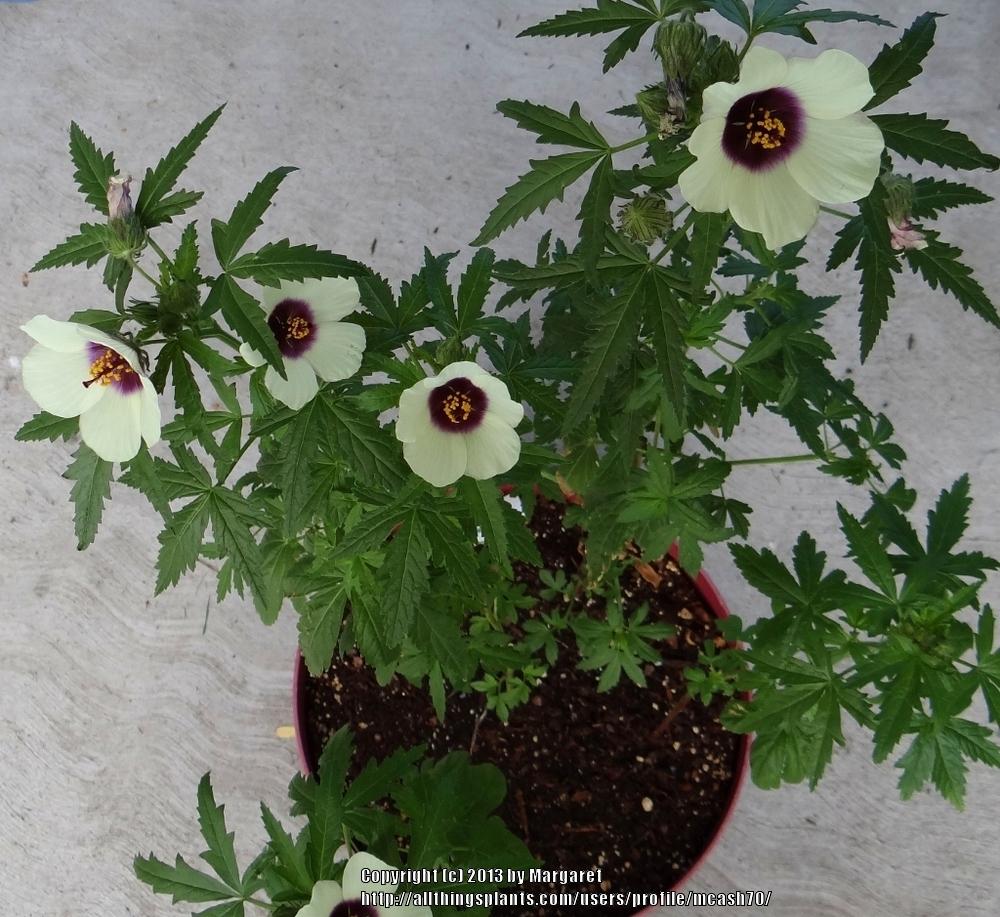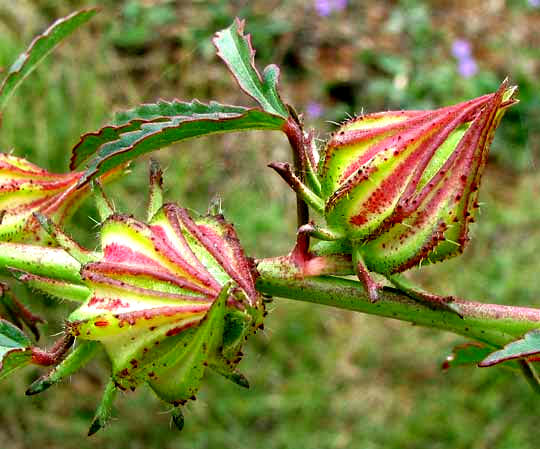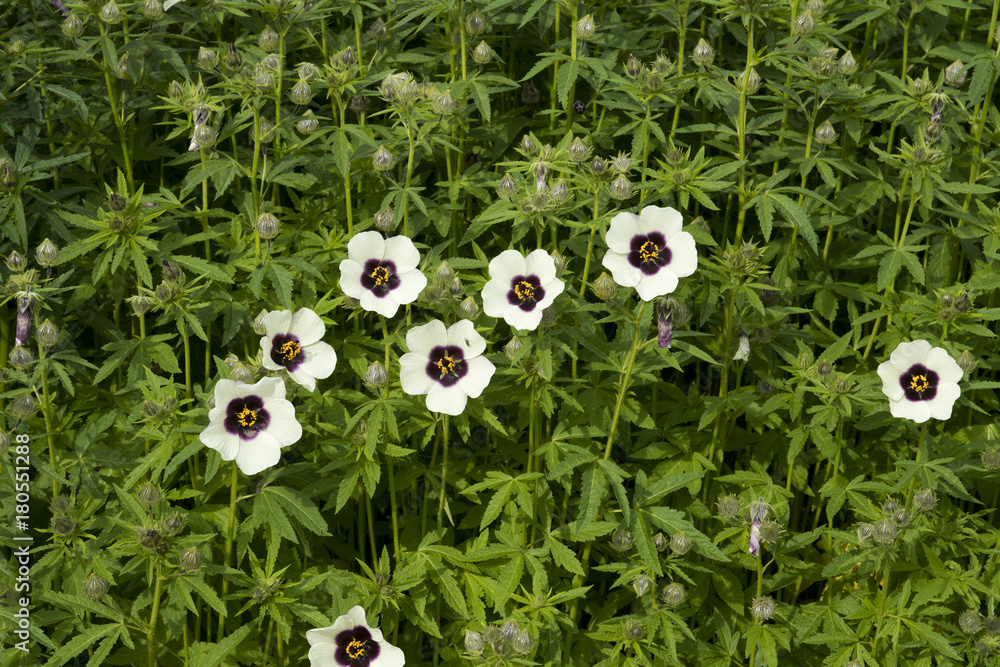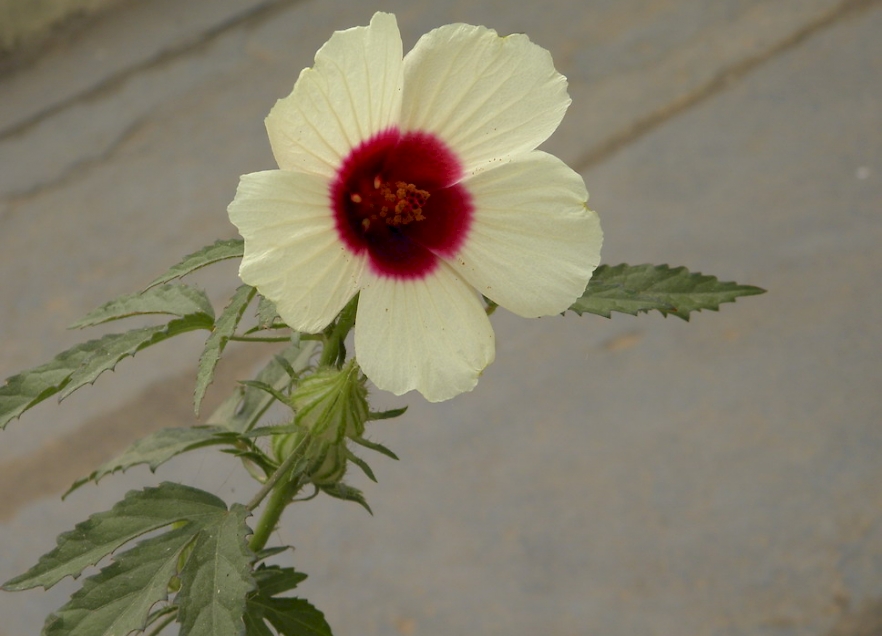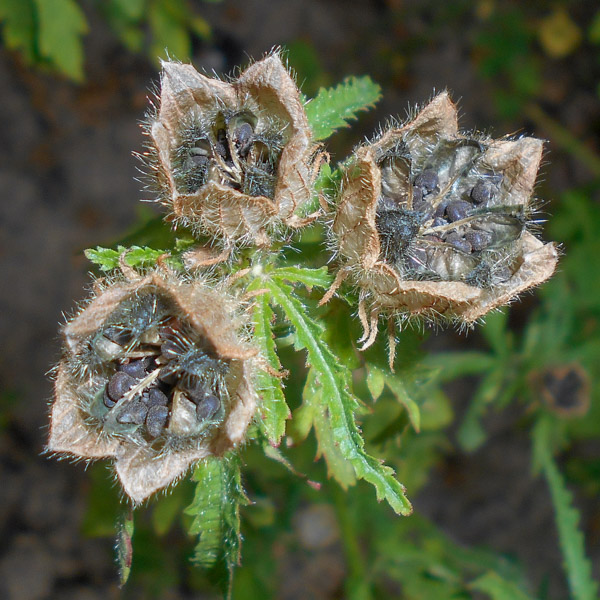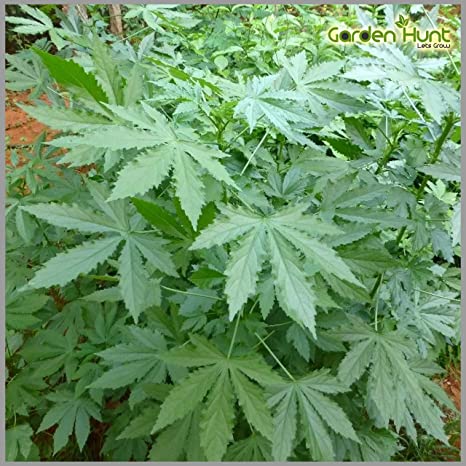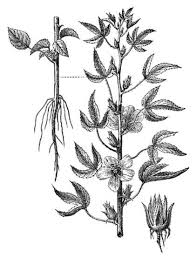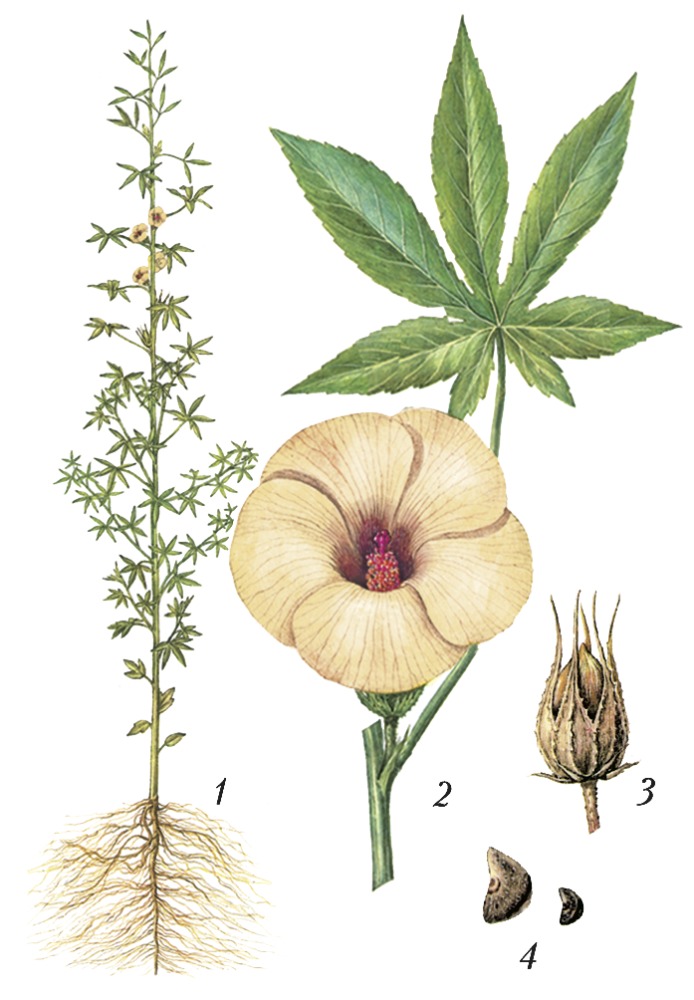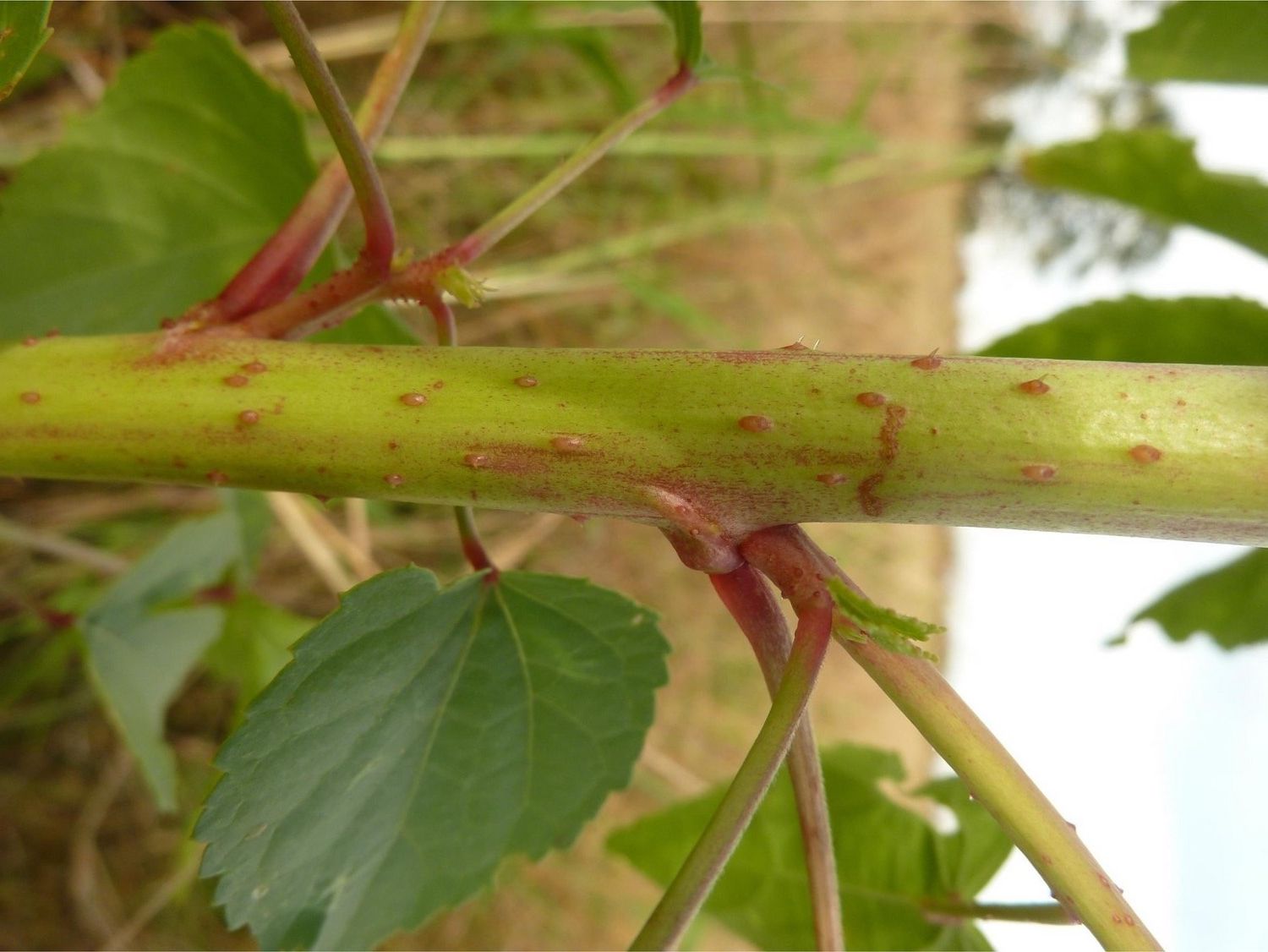Kenaf is an amazing plant that has a wide range of uses. Because it can be used in so many ways, it can be used to make food, medicine, and other goods. It has been grown for thousands of years mostly for its fiber, which is used to make clothes, paper, bio-composites, and feed for animals. In recent years, the plant has become known as an option to traditional crops that is sustainable and good for the environment. Its low cost and many uses have brought it a lot of attention and now Kenaf is seen as a useful addition to any agricultural operation.
Kenaf Facts
| Kenaf Quick Facts | |
|---|---|
| Name: | Kenaf |
| Scientific Name: | Hibiscus cannabinus |
| Origin | Central Africa |
| Shapes | Small, round pods that are usually about 2 to 3 cm in diameter. |
| Taste | Nutty flavor |
| Health benefits | Lowers cholesterol, Anti-inflammatory properties, Digestive health, Cardiovascular health, Anti-cancer properties, Immune system support, Weight management, Skin health, Bone health |
| Name | Kenaf |
|---|---|
| Scientific Name | Hibiscus cannabinus |
| Native | Central Africa, but it is now widely cultivated in other parts of the world, including Asia, Australia, and the Americas |
| Common Names | Deccan hemp, Java jute, wild stock rose, Brown Indian Hemp, bastard jute, bimli jute, bimlipatum jute, Bombay hemp, Deckaner hemp, Guinea hemp, Indian hemp, vegetable kenaf, kénaf, ambari hemp, mesta, chanvre de Bombay, ambari, Bimlipatam jute, Gambo hemp, Gombo hemp, Hemp hibiscus, Hibiscus hemp, Mesta, Rosella hemp, Roselle, Siam jute, Thorny mallow |
| Name in Other Languages | Afrikaans: Kenaf, stokroos, Wildestokroos Albanian: Kenaf Amharic: Kenaf (kəˈnaf) Arabic: Alkunaf (الكناف), jiljil (جلجل) Armenian: K’enaf (քենաֆ) Assamese: Nalita Azerbaijani: Kenaf Bambara: Ntorida Basque: Kenaf Belarusian: Kenaf (Кенаф) Bengali: Kenaf (kəˈnaf), mesta, Patsan, Ambari, Mestapat Bihari: Kudrum Brazil: Cânhamo-brasileiro, papoula-de-são-francisco, quenafe Bulgarian: Kenaf (кенаф), konopen khibiskus (конопен хибискус) Burmese: Af Catalan: Kenaf Chinese: Hóng má (红麻), Yang ma (洋麻), Fu rong ma (芙蓉麻), Da ma jin (大麻槿), Zhōng má (鐘麻), Cūcāo mùjǐn (粗糙木槿) Czech: Kenaf Dagbani: Birimia Danish: Kenaf, Hamp, Javajute, Kenaf, Rosellahamp, Rosellehamp, Siamjute Dutch: Braziliaans vlas, Javajute, Kenaf, Rosella hennep, Roselle, Siamjute English: Kenaf, Ambari hemp, Brown Indian hemp, Deccan hemp, Bombay hemp, bastard-jute, bimli-jute, Java-jute, kenaf hibiscus, Indian hemp, Bimlipatam jute, Gambo hemp, Gombo hemp, Guinea hemp, Hemp hibiscus, Hibiscus hemp, Mesta, Rosella hemp, Roselle, Siam jute, Thorny mallow, Wild stockrose Esperanto: Kenaf, Kenafo Estonian: Kenaf Filipino: Kenaf Finnish: Kenafia French: Kenaf, chanvre de Bombay, chanvre du Deccan, chanvre de Guinée, chanvre de Gambo, chanvre de roselle, jute de Java, jute de Siam, kénaf, ketmie à feuilles de chanvre, roselle Fulah: Follere Georgian: K’enapi (კენაფი) German: Kenaf, Ambari, Dekkanhanf, Gambohanf, Hanfeibisch, Javajute, Kenaf, Rosellahanf, Roselle, Siamjute, Ambari, Jawa-Jute, Greek: Kenaf (kəˈnaf) Gujarati: Kēnāpha (કેનાફ), Sheria, Ambary, Sheria Hausa: Kenaf Hebrew: Kenaf, kinf (קינף) Himachal (Pangolu): Sunn Hindi: Kenaf (kəˈnaf), Patsan (पटसन), San (सन), Ambari, Pitwa, mesta Hungarian: Kenafból, Rostmalyva Icelandic: Kenaf Indonesian: Kenaf, Mesta, patsan, pitwa Iran: Kanaf Irish: Kenaf Italian: Kenaf, Canapa di Bombay, Canapa rosella, Ibisco, Juta del Siam, Jute di giava Japanese: Kenafu (ケナフ) Javanese: Kenaf Kannada: Kenāph (ಕೆನಾಫ್), Pundi Palle, Pundi (ಪುಂಡಿ), Gogu (ಗೋಗು), Pundrike (ಪುಂಡ್ರಿಕೆ) Holada pundrike (ಹೊಲದಪುಂಡ್ರಿಕೆ), Dirin da rani, Ambade, Gogu, Kasala gida, Pindi soppu, Pinidrikegida Kazakh: Kenaf (кенаф) Kinyarwarwanda: Uruberwa Kirghiz: Kenaf (Кенаф) Konkani: Ambadi Korean: Ke napeu (케 나프), yangma (양마) Kurdish: Kenaf Lao: Kenaf (kəˈnaf), po aekv (ປໍແກ້ວ ) Latin: Kenaf Latvian: Kenafs Lingala: Bokai, Takataka Lithuanian: Kenafas Macedonian: Kenaf (кенаф), konopen khibiskus (конопен хибискус) Malagasy: Kenaf Malay: Kenaf Malayalam: Kenāph (കെനാഫ്), Kanjaru (കംജരു), mesta (മെസ്റ്റ) Maltese: Kenaf Manipur: Shougri, Saugaraī (সৌগৰী) Marathi: Kenaaph (केनाफ), Ambaadi, Ambari (अंबरी) Mongolian: Kenaf (кенаф) Myanmar: Chin-baung-gyi,chin-baung-kha Nepali: Kenaaph (केनाफ), Kudram, Kunjar, Maarangii, Patsan, Kudram, Kunjar, Maarangii, Patsan Netherlands: Braziliaansch Vlas Norwegian: Kenaf Orissa: Kanuriya Oriya: Kenaf, Kanuriya, କାଉଁରିଆ Pashto: کیناف Persian: کنف, Kanaf کنف, کنف Polish: Kenaf, Czyli kenaf, Ketmia konopiowata Portuguese: Kenaf, cânhamo rosella, juta-de-java, juta-do-sião, quenafe, papoula-de-são-francisco, cânhamo-brasileiro, quenafe, caruru-azedo, cânhamo-do-decão, linho-de-gombo Punjabi: Kēnāpha (ਕੇਨਾਫ) Romanian: Chenat Russian: Kenafa (кенафа), gibiskus konoplovyy (гибискус коноплёвый), kanap (канап), kenaf (кенаф) Sanskrit: Machika (मचिका), Maryurika (मयूरिका), Ambika (अम्बिका), Sahasravatamulika, Alka, Ambalika, Ambashtha, Chitrapushpi, Gandhapatri, Karaparni, Keshi, Machika, Phalamla, Rajjudatri Sahasravatamulika, Shreyasi, Vrttabija Serbian: Kenaf (кенаф) Shona: Sosoori Sindhi: Kenaf Sinhala: Kenaf (kəˈnaf) Slovenian: Kenaf Spanish: Kenaf, cáñamo de la India, cáñamo de gambo, cáñamo Rosella, pavona encendida, yute de Java, yute de Siam, flor de San Juan, apocino Sundanese: Kenaf Swedish: Kenaf Taiwan: Ambari Tajik: Kenaf (кенаф) Tamil: Keṉāḥp (கெனாஃப்), pulicha keerai (புளிச்சைக் கீரை) Palungu (பலுஂகு), Palunku (பலுஂகு), Pulimanji, Canampu, Cetikkacuraikkirai, Kaccurakkirai, Phalungu, Pulichhi, Pulimanjai, Pulimanji, Valikai, பலுஂகு Palungu, Puḷiccai (புளிச்சை) Telugu: Kenaf (kəˈnaf), Gongura, Taag-Ambadi, Puntikura, Pimdikura, Gonkura, Gaynaru, Ghongukuru, Gogu, Gongoora, Gulunguchettu, Pundikura Thai: Px kæ̂w (ปอแก้ว), Po, Po dai, Po kaeo Turkish: Kenaf, HIibiskus Ukrainian: Kenaf (кенаф), hibisk konoplevyy (гібіск коноплевий) Urdu: Mushkadanah, کیناف Uzbek: Kenaf Vietnamese: Kenaf Welsh: Kenaf Zulu: Kenaf |
| Plant Growth Habit | Annual or biennial, unbranched or branched, fast growing, woody to herbaceous (rarely a short-lived perennial) plant |
| Growing Climates | Cultivated land, old gardens, dikes between irrigated fields, ridge tops in shallow soil, rocky fissures, talus, open grassland plains, savannahs, flood plains, seasonal swamps |
| Soil | Prefers soil that drains well and does not become waterlogged. Excess water can lead to root rot and other plant diseases. Soil that is rich in organic matter, such as compost or well-rotted manure, can provide the necessary nutrients for healthy Kenaf growth. Soil that is too acidic or alkaline can affect nutrient uptake and plant growth |
| Plant Size | Around 1.5–3.5 m tall with a woody base, though some selected cultivars can be up to 5 meters |
| Root | Taproot well developed, up to 25 cm deep with lateral roots spreading horizontally to 1 m and adventitious roots on lowest stem section |
| Stem | Slender, cylindrical, in cultivation unbranched and glabrous, prickly on wild accessions |
| Leaf | Big and have a lobe-like shape. They can be up to 15 cm long and 20 cm wide. They have opposite and palmately compound leaves, and each leaf is made up of several leaflets |
| Flowering season | August to September |
| Flower | Flowers are 8–15 cm diameter, white, yellow, or purple; when white or yellow, the center is still dark purple. |
| Fruit Shape & Size | Small, round pods that are usually about 2 to 3 cm in diameter, containing several seeds |
| Seed | Small and oval, and they grow inside the fruit pods of the plant. They are about 3–4 mm long and have a hard, dark-colored seed coat. |
| Flavor/Aroma |
|
| Taste | Nutty flavor |
| Plant Parts Used | Leaves, flowers, oil, root, seed |
| Propagation | By seed or from stem cuttings |
| Lifespan | Can range from a few months to up to 2 years, depending on its intended use and growing conditions. |
| Season | October to November |
| Varieties |
|
| Health benefits |
|
Plant Description
Kenaf is a fast-growing annual or biennial plant that can grow up to 1.5–3.5 meters tall, and some types can grow up to 5 meters tall. It can grow in a woody or grass way, and it can have or not have branches. This plant grows in many different places, like on farmland, in old gardens, in shallow soil on hill tops, in rocky cracks, in flood plains, and in seasonal swamps. It likes dirt that drains well, because too much water can cause root rot and other diseases. Soil with a lot of organic matter, like well-rotted soil or compost, gives Kenaf the nutrients it needs to grow well. The pH of the soil is also very important. If the soil is too acidic or alkaline, it can make it hard for plants to take in nutrients and grow. To make sure Kenaf grows and develops as well as it can, it is important to give it the right soil conditions.
Root
The taproot system of Hibiscus cannabinus is made up of a deep, central root that can grow up to 2.5 meters long. This deep root structure lets the plant get water and nutrients from lower soil layers, so it doesn’t need to be watered as much and can handle drought better. The plant’s deep roots also help stop soil erosion by keeping the soil in place and stabilizing slopes, which is especially helpful in areas with steep slopes or that are prone to erosion. So, Hibiscus cannabinus not only has many benefits, but it also helps protect the environment by keeping the soil from washing away.
Stem
The base of kenaf is strong and can grow up to 5 meters tall. The stem is straight, has a cylinder shape, and is about 2 to 3 centimeters in width. It is made up of many layers of fibers and has a tough bark on the outside. The plant has a lot of fiber, which can be used to make things like clothes, paper, ropes, and building materials. The threads last a long time and are strong, so they can be used in many different ways. Kenaf is not only used in farming and business, but it is also used in traditional medicine. As a crop with fibers, it is an important part of ecological farming and an important source of renewable materials. Kenaf is a valuable plant that helps several businesses and promotes sustainable practices. Its stem is strong and durable, and it can be used in many ways.
Leaves
The leaves of kenaf are big and have a lobe-like shape. They can be up to 15 cm long and 20 cm wide. They have opposite and palmately compound leaves, and each leaf is made up of several leaflets that are grouped like fingers on a hand. The leaves range in shape from ovate to lanceolate, and their edges are toothed. The top of the leaves is smooth and shiny, but the bottom is covered with tiny hairs. The leaves of Kenaf are usually green, but some types have leaves that are reddish or purple. Kenaf leaves have a unique shape and size, which adds to the plant’s total beauty and usefulness.
The leaves of the kenaf plant have been used as medicine for hundreds of years in many different countries. They have chemicals in them like flavonoids, phenolic acids, and carbohydrates that help fight free radicals, inflammation, and bacteria. Extracts from these leaves have been used to treat coughs, fevers, diarrhea, and skin diseases, among other things. Kenaf leaves can be used to make medicine, but they can also be eaten and fed to animals. They are full of nutrients and can be eaten raw or cooked. They are high in protein, fiber, and vitamins. In some countries, the leaves are used to cook food in the same way that grape leaves are used in Mediterranean cooking. In conclusion, kenaf leaves are a useful resource that can be used in many ways in traditional medicine, farming, and industry. Because they are full of nutrients and have healing qualities, they are an important part of many traditional diets and remedies.
Flower
The flowers of kenaf are a beautiful and unique part of the plant. These beautiful flowers can be up to 10 cm in diameter and are usually yellow, but they can also be white, pink, or red. The flowers are very similar to those of other hibiscus species. They have five petals that overlap and circle a large stamen in the middle. The petals are slightly folded and have a delicate feel, and the stamen is thin and long, with a yellow or red anther at the end. Kenaf flowers are not only pretty to look at, but they also have cultural and medical value. In some countries, they are used in traditional ceremonies and rituals, while in others, they are used to make herbal medicines. The flowers of Kenaf show that the plant has both an aesthetic and a spiritual value.
Kenaf’s flowers are important for more than just culture and medicine. They are also a key source of food for pollinators like bees and butterflies. The plant’s many and colorful flowers attract a wide range of pollinators, such as honeybees and bumblebees. This increases biodiversity and helps local environments by bringing in more pollinators. Kenaf’s flowers are an important and useful part of the plant because of how beautiful they are and how important they are for the environment.
Fruits
After the flowers are pollinated, the fruits of kenaf are small, round pods that are usually about 2 to 3 cm in diameter. These pods have a hard shell with a few small seeds inside. The seeds are an important part of the life cycle of the plant because they can be used to grow new plants. Also, they are an important source of protein and oil, and they can be used in a wide range of farming and industrial settings. In conclusion, Kenaf’s fruits are an important part of the plant’s life cycle and have many uses in food, business, and medicine.
Seeds
Kenaf seeds are small and oval, and they grow inside the fruit pods of the plant. Most of the time, they are about 3–4 mm long and have a hard, dark-colored seed coat. These seeds are an important source of oil and protein, which makes them a useful crop for food and industry. Depending on how they grow and what kind they are, kenaf seeds can have anywhere from 20% to 35% oil. The oil made from the seeds has a lot of polyunsaturated fatty acids, which help reduce inflammation and lower cholesterol levels, among other health benefits. In conclusion, kenaf seeds are a useful resource that can be used in many ways, including food, industry, and traditional medicine. Because they have a lot of oil and protein, they are an important crop for healthy farming and a source of renewable materials.
History
Kenaf has been around for thousands of years and has a long and interesting past. It comes from Africa. It was first grown for its fiber, which was used to make a wide range of fabrics, clothes, and ropes. Over time, more places around the world, like Asia and the Middle East, started growing kenaf. The big leaves and fibrous stem of the plant made it a valuable resource for many things, from making paper to traditional medicine. In the 1800s, kenaf was brought to the United States as a possible replacement for cotton and other fabric crops. It became very famous very quickly in the southern states, where it was grown for its strong and durable fiber. In conclusion, Kenaf has a long and interesting past, and its many uses have made it a valuable crop all over the world.
During World War II, the U.S. government encouraged the growing of Kenaf as a way to meet the need for fiber and lessen the country’s reliance on materials that had to be brought in from other places. Kenaf was grown on a large scale. More than 20,000 acres of land were used to grow it. In the years that followed, kenaf was still grown for its fiber, but it became known for its many other uses as well. Its seeds were found to be an important source of oil and protein, and its leaves and flowers were used in traditional medicine. Today, kenaf is grown all over the world, including in places like Asia, Africa, and North America. The most valuable part of the plant is still its fibrous stem, which is used to make paper, fabrics, and building materials, among other things.
Types/Varieties
There are many different kinds of kenaf grown all over the world, and each has its own unique traits and uses. Here are some of the most common varieties:
- Tainung 2: This type is a popular choice in Taiwan because it makes a lot of fiber and the fibers are strong.
- Everglades 41: This type was made in the United States, and it does well in the hot and humid southern states. It is usually grown for its fiber, which is used to make things like paper and clothes.
- Cuba 108: This type is grown in Cuba, and it is known for having a lot of oil in it. The seeds are used to make oil, which is used in cooking and other places.
- CSH 1: This type was created in India, where it grows well in the hot and dry climate. It is grown for its fibers, which are used to make paper and clothes.
- Guangzong 1: This type is grown in China, and its high fiber output and strong fibers are well-known. It is often grown with other crops, like wheat or corn, in a cycle.
- AKEN-97: This variety was made in Japan, and it does well in the temperature there. It is grown for its fiber, which is used to make paper, clothes, and materials for building.
- VIKING: This variety was made in Germany and does well in the temperature of Europe. It is grown for its fibers, which are used to make paper and clothes.
- UH-14: This variety, which was made by the University of Hawaii, is known for its high output and high quality fiber.
- Voronezhskaya: This type was made in Russia, and it can handle cold and has good fiber quality.
Health benefits of Kenaf
Kenaf is an African plant that is now grown in many places around the world. It is linked to okra and cotton and is in the same family as hibiscus. Kenaf has a number of health benefits, including:
1. Lowers cholesterol
Kenaf has chemicals in it that can help lower the amount of cholesterol in the blood. This lowers the risk of getting heart disease.
2. Anti-inflammatory properties
Kenaf has anti-inflammatory chemicals that can help reduce inflammation all over the body. This could lower the risk of getting arthritis, diabetes, or cancer.
3. Digestive health
Kenaf is a good source of dietary fiber, which is good for digestive health because it makes stools bulkier, prevents constipation, and keeps the bacteria in the gut healthy.
4. Cardiovascular health
Kenaf has beneficial compounds like flavonoids and lignans that have anti-inflammatory and antioxidant effects. These chemicals can help lower blood pressure, lower cholesterol, and improve blood flow, which may lower the chance of heart disease.
5. Anti-cancer properties
In lab tests, polyphenols and polysaccharides found in kenaf, which is a plant, have been shown to help fight cancer. These chemicals can stop cancer cells from growing and make them die, which could help prevent or treat cancer.
6. Immune system support
Kenaf is full of vitamin C and other antioxidants, which can help your immune system and make you healthier generally. Vitamin C can also lower swelling and help the body make collagen, which is important for healthy skin, bones, and joints.
7. Weight management
Kenaf has a lot of fiber, which can help you feel full, reduce your hunger and calorie intake, and help you control your weight. The fiber can also control the amount of sugar in your blood, keeping it from going up and down in a way that can make you want to eat.
8. Skin health
Essential fatty acids like omega-3 and omega-6 are found in kenaf seed oil. These acids can improve skin health by reducing inflammation, making the skin’s barrier work better, and helping skin cells grow back. It can also make skin more flexible and lessen the look of wrinkles.
9. Bone health
Kenaf has nutrients in it that are important for bone health, like calcium, magnesium, and phosphorus. These nutrients can stop bone loss and make osteoporosis less likely.
Traditional uses and benefits of Kenaf
- In traditional medicine, leaves have been used to treat fever, lung problems, and nausea.
- Extracts from the stem have been used to treat fever, inflammation, and stomach problems, among other things.
- People have used the flowers, leaves and seeds to treat pain and swelling.
- In Gambia, a tea made from the leaves is used to treat coughs.
- Flowers are used for constipation and biliousness.
- Seed oil is used on the outside of the body to treat pain and cuts, and on the inside as an aphrodisiac.
- It is used in Africa and India to treat blood and stomach problems, conditions that cause bile to build up, fever, and painful menstruation.
- In Kenya, spider bites are treated with crushed roots, and stomach problems are treated with the leaves.
- In West Africa, powdered leaves are used to treat rashes and boils, and a tea made from the leaves is used to treat coughs.
- It is used to treat anemia and liver illnesses in traditional African medicine.
- In Africa, powdered leaves are used to treat Guinea worms.
- The leaves are used to treat stomach problems and aches and bruises on the outside of the body by making a poultice.
- The juice of the flowers is used to treat bile with acidity when it is mixed with sugar and black pepper.
- Seeds are added to a diet to help a person gain weight.
- Stem peelings have been used to treat anemia, tiredness, lassitude, and other conditions.
Culinary Uses
Kenaf seeds and leaves have culinary uses in various cultures. Here are some examples of culinary uses of kenaf:
- Cooking oil: When kenaf seeds are pressed, the oil that comes out can be used to cook and fry. The oil tastes like nuts and is full of polyunsaturated fatty acids.
- Beverage: In some parts of the world, kenaf leaves are used to make a drink that tastes like tea. The leaves are put in hot water and then honey or sugar is added to make it taste better.
- Soup: Lalo is a soup made in West Africa from kenaf leaves. The leaves are boiled with meat, fish, or veggies and then spiced.
- Sauce: In India, the seeds of kenaf are used to make a sauce that is similar to chutney. Spices, garlic, and ginger are ground up with the roasted seeds.
- Snack: As a snack, kenaf seeds that have been cooked are eaten in some Asian countries. The seeds taste like nuts and are seasoned with salt or spices.
Other Culinary Uses
- Like grape leaves, kenaf leaves can be used to wrap and cook food. In some places, people like to eat stuffed kenaf leaves.
- Kenaf seeds can be cooked and ground into flour, which can be used to make baked goods like bread and cakes.
- Like other legumes, kenaf seeds can be boiled and used in soups and stews.
- You can chop up kenaf leaves and add them to salads or use them as a garnish.
- In some places, kenaf seeds are used to make a traditional sweet called “halawa.”
- You can cook and eat the leaves and young shoots as a veggie.
- Children chew on raw bark because it tastes sweet.
- Pickles and chutneys are made with the leaves.
Different Uses
Kenaf is a versatile plant with a range of benefits. Here are some of the benefits of Kenaf:
- Sustainable fiber source: Kenaf is a fast-growing plant that is grown for its fiber, which can be used to make paper, fabrics, and biodegradable plastics, among other things.
- Low environmental impact: Kenaf needs less water and manure than many other crops, so farmers can grow it in a more environmentally friendly way. It also leaves behind a small amount of carbon and can help cut down on greenhouse gas emissions.
- Animal feed: The leaves and roots of kenaf can be used to feed animals because they are full of protein, fiber, and other nutrients.
- Economic benefits: Growing and preparing kenaf can be a good way for farmers to make money, especially in places where other crops may not do well.
- Soil improvement: Kenaf has deep roots that can help improve the health of the soil by adding organic matter and making the structure of the soil better. The plant can also take in extra nutrients from the earth, which makes nutrient pollution less likely.
- Fuel: Kenaf can be used as a biofuel because it has a lot of cellulose and lignin, two substances that can be turned into ethanol and biodiesel.
- Paper: Kenaf fibers are used to make paper because the fibers are long and make strong paper. Kenaf paper is also better for the environment than other kinds of paper because it needs less water and chemicals to make.
- Industrial uses: Kenaf can be used to make padding, building materials, and biodegradable plastics, among other things. Because they are made from renewable resources and biodegrade, these goods are more eco-friendly and sustainable than traditional materials.
- Ornamental plant: Kenaf is sometimes grown as a decorative plant because its leaves and flowers are so pretty.
Other Uses
- Kenaf is a low-maintenance crop that needs little fertilizer and pest control.
- Kenaf has a high biomass yield and can make up to 10 tons of dry matter per acre.
- Kenaf can take in a lot of carbon dioxide from the air, which makes it a good food for the environment.
- Kenaf can grow in places with low rainfall and can handle some drought.
- Kenaf fiber is a sustainable alternative to synthetic fibers and is used more and more in eco-friendly goods like clothing, bags, and packaging.
- Kenaf can be grown with other crops to improve the health and fertility of the land.
- Kenaf is resistant to many common pests and diseases, so it is a low-input crop that needs only a small amount of chemicals.
- Kenaf has been used for hundreds of years to make native textiles and crafts, like rope, baskets, and paper.
- Fiber is naturally white and feels like jute or flax. This makes it a good option to synthetic fibers that aren’t good for the environment.
- The plant is usually grown from a seed, and after 4-5 months, it can be picked.
- Kenaf is ready to use after 100 to 200 days.
- The seeds make oil that can be eaten and used in cooking.
- Oil can also be burned, used as a lubricant, and used to make soap, paints, and coatings.
- Cattle feed comes from young, whole plants.
- The seed cake can be eaten and can be used to feed animals or as a fertilizer.
- The stem has been used as a place to start digging for fire.
- Stems that have been dried and stripped of their fibers can be used as fuel.
- Black paints have been made with the soot from the stems.
- Oil can be burned, used as a lubricant, and is also used to make soap, linoleum, paints, and oils.
- Stems have been used to hold up plants like string beans and so on.
- Fiber strands are used to make rope, cordage, canvas, sacking, carpet backing, nets, tablecloths, etc.
- Twine, rope, and shoes with rope soles are also made from the fibers.
- The fiber is turned into mats and rugs in some places.
Precautions
While kenaf is generally considered safe for human consumption and use, there are some precautions to keep in mind:
- Allergies: Some people may be sensitive to kenaf, especially if they are allergic to other plants in the hibiscus family.
- Medicinal uses: If you want to use kenaf as a medicine, you should talk to a medical worker to make sure it is safe and effective.
- Pesticides and herbicides: As with any crop, it’s important to know that chemicals and herbicides might be used to grow kenaf. By choosing kenaf goods that are grown organically and in a sustainable way, you can reduce your exposure to harmful chemicals.
- Fibers: If you don’t handle kenaf fibers the right way, they can irritate your skin or cause breathing problems. It’s important to take the right precautions when dealing with kenaf fibers.
- Cooking and storage: When making with kenaf, make sure to follow food safety rules to keep the food from getting contaminated. Keep kenaf seeds and other items in a cool, dry place to keep them from going bad.
- Fire risk: Kenaf fibers are very flammable, so they should be kept away from heat and light sources.
- Skin irritation: Some people may get irritated skin when they touch Kenaf plants or fibers. When handling the plant or its products, it is best to wear protective clothes like gloves and long sleeves.
References:
https://en.wikipedia.org/wiki/Kenaf
https://www.feedipedia.org/node/141
https://www.flowersofindia.net/catalog/slides/Kenaf.html
http://www.stuartxchange.com/AlasDoce.html
http://www.theplantlist.org/tpl1.1/record/kew-2849657
https://indiabiodiversity.org/species/show/229949
https://uses.plantnet-project.org/en/Hibiscus_cannabinus_(PROSEA)
https://gd.eppo.int/taxon/HIBCA
https://www.wikidata.org/wiki/Q1137540
https://nordic-baltic-genebanks.org/gringlobal/taxonomydetail.aspx?id=19012
https://pfaf.org/user/Plant.aspx?LatinName=Hibiscus+cannabinus
http://www.hear.org/pier/species/hibiscus_cannabinus.htm
https://www.itis.gov/servlet/SingleRpt/SingleRpt?search_topic=TSN&search_value=21623#null
https://tropical.theferns.info/viewtropical.php?id=Hibiscus+cannabinus
https://www.hort.purdue.edu/newcrop/duke_energy/Hibiscus_cannabinus.html
https://plants.usda.gov/home/plantProfile?symbol=HICA5


